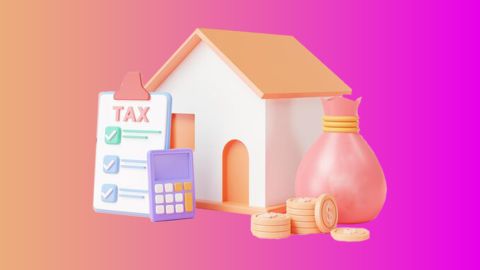The Government of India encourages homeownership by offering tax benefits through home loans. These provisions reduce the financial burden by allowing deductions from your taxable income on both interest and principal repayment. To make this process easier, you can use a Home Loan EMI Calculator with Tax Benefit, which helps you calculate potential tax savings in advance. By factoring in your equated monthly instalments (EMIs), such a home loan tax deduction calculator provides clarity on how much relief you can claim. This makes borrowing more affordable and ensures you plan your finances with greater accuracy and confidence.
When planning for homeownership, securing the right loan at competitive rates maximises your tax benefits. Bajaj Finserv offers home loans starting at just 7.45%* p.a, helping you save more on both interest payments and tax deductions. Check your eligibility for a home loan from Bajaj Finserv today. You may already be eligible, find out by entering your mobile number and OTP.
What is a home loan tax benefit?
Buying a home is a long-term aspiration and a major financial step. A home loan not only helps you achieve this milestone but also provides significant tax savings as per the Income Tax Act of 1961.
If you have taken a home loan from a lender such as Bajaj Finserv housing finance, you can claim deductions under different provisions. For example, Section 24 of the Income Tax Act allows you to claim a deduction on the interest paid, up to Rs. 2,00,000 annually for self-occupied properties. In the case of rented properties, there is no maximum cap on this deduction.
Additionally, under Section 80C of the Income Tax Act, you may claim up to Rs. 1,50,000 in a financial year on the principal repayment, including expenses like stamp duty and registration fees. However, these benefits are valid only if the property is not sold within five years.
To maximise these tax advantages, choosing a lender with competitive rates and flexible terms is essential. Bajaj Finserv offers home loans with attractive interest rates and tenure options up to 32 years, ensuring optimal tax planning opportunities. Check your loan offers with Bajaj Finserv today. You may already be eligible, find out by entering your mobile number and OTP.
When it comes to a second property, the rules differ. The home loan tax benefit for principal repayment is not applicable, and interest-related deductions vary depending on whether the property is rented, self-occupied, or still under construction. Tools such as a home loan tax exemption calculator or housing loan tax benefit calculator help you estimate savings with precision.
What is a home loan tax benefit calculator
A home loan tax benefit calculator is an online tool that helps you calculate the tax benefits associated with your home loan. By entering key financial details, you can determine potential deductions and savings on income tax. Thus, you can optimise the tax planning for your home loan.
Note: The principal and interest component changes every month during the repayment tenure. Typically, in the initial phase of repayment, a major part of your EMI comprises interests and as the tenure progresses, the principal part increases.
What is a home loan tax benefit?
A home loan does not just help you buy or build your dream house—it can also reduce how much income tax you pay each year. The Indian Income Tax Act of 1961 offers several ways to lower your tax if you have taken a loan from a recognised lender like Shriram Housing Finance.
You can claim a deduction under Section 24 on the interest you pay for the loan. This is limited to Rs. 2,00,000 for a self-occupied home, but there is no upper limit if the house is rented out. In both cases, the loan should be used for buying, building, repairing, or renovating the property.
Another benefit comes under Section 80C, where you can claim up to Rs. 1,50,000 a year on the principal part of your loan EMI. This section also covers costs like stamp duty and registration charges during home purchase.
However, tax rules are different for second homes or houses still under construction. Principal repayment benefits are not available for under-construction properties, and interest deductions may vary depending on whether the property is self-used or rented.
To know exactly how much you can save, a home loan tax benefit calculator is a helpful tool that gives quick, accurate results based on current tax laws.
Planning to buy your dream home and want to maximise your tax savings? Bajaj Finserv offers home loans with competitive interest rates starting from 7.45%* p.a, helping you save on both your purchase and taxes. Check your eligibility for a Bajaj Housing Finance Home Loan today. You may already be eligible, find out by entering your mobile number and OTP.
How to use the home loan tax benefit calculator
With our home loan tax benefits calculator, you can instantly estimate accurate and easy tax savings on your home loan. Follow these simple steps to calculate your benefits:
- Enter your annual income
- Interest paid on your home loan
- Principal repaid on your home loan
Once you enter these details, you will be able to view the total income tax payable on your home loan, income tax payable before home loan and after home loan.
Formula for the home loan tax benefit calculator
A housing loan tax benefit calculator is a useful tool that gives a detailed estimate of tax relief available on your home loan. It evaluates factors such as income, interest rates, principal repayment, and investments under Section 80C. Let’s understand this with an example.
Suppose your annual income is Rs. 10,00,000, and you have taken a home loan of Rs. 40,00,000 for a period of 15 years. The rate of interest is 8% per annum. You have also invested Rs. 50,000 in other schemes covered under Section 80C.
Here’s how your tax calculation may look with the help of a home loan tax exemption calculator:
- Principal loan amount: Rs. 40,00,000
- Annual income: Rs. 10,00,000
- Tenure: 15 years
- Interest Rate: 8% p.a.
- Other 80C investments: Rs. 50,000
- Tax payable before loan: Rs. 1,20,000
- Tax payable after loan: Rs. 70,000
- Tax saved due to home loan: Rs. 50,000
By using a home loan tax benefit calculator, you can clearly see the difference in tax liability before and after considering loan-related deductions. This ensures transparency and helps borrowers understand how much they save through the loan.
Advantages of a home loan tax deduction calculator
A home loan tax exemption calculator is an effective digital tool that simplifies tax planning. By combining details of your loan and income, it generates quick results, giving you a realistic idea of your tax benefits.
Here are the key advantages of using this calculator:
- Ease of use – A simple and hassle-free tool that requires only basic details.
- Accuracy – As an automated system, it minimises errors compared to manual calculation.
- Comprehensive input factors – Considers elements like annual income, interest rate, principal, home loan EMIs, and other tax deductions.
- Clear eligibility insights – Helps determine which deductions you qualify for and the final payable tax amount.
- Informed planning – With a home loan tax saving calculator, you can estimate benefits beforehand and plan your finances better.
While calculators help estimate tax benefits, securing pre-approved loan offers gives you real savings potential. Bajaj Finserv provides quick loan approvals within 48 hours* and competitive rates that enhance your actual tax deductions. Check your eligibility for a home loan from Bajaj Finserv now. You may already be eligible, find out by entering your mobile number and OTP.
Explore other home loan calculators
|
Apply for a home loan in different cities
Home loan options for different budgets
Frequently asked questions
You can save tax on both the interest and the principal of your home loan. Under Section 24, you may claim up to Rs. 2,00,000 on interest payments. Under Section 80C, you can claim up to Rs. 1,50,000 on the principal repayment, depending on your income and loan details.
The maximum tax deduction available is Rs. 2,00,000 on interest under Section 24(b), and Rs. 1,50,000 on the principal under Section 80C. This depends on whether the property is self-occupied or rented, and whether you meet all other conditions set under the tax rules.
Home loan repayments fall under Section 80C, not Section 80D. You can claim a deduction of up to Rs. 1,50,000 on the principal paid, but the house should not be sold within five years from the date of possession, or the claimed benefit may be reversed.
The old tax regime is better for those who want to claim home loan tax benefits. If you have many deductions, especially on interest and principal, the old regime usually leads to more savings. The new regime does not allow most deductions, including home loan benefits.Since the old tax regime maximises your home loan benefits, it makes sense to choose a lender that offers competitive rates to amplify your savings. Bajaj Finserv provides home loans with attractive interest rates and flexible terms that work well with tax planning strategies. Check your eligibility for a Bajaj Housing Finance Home Loan to optimise both your purchase and tax benefits. You may already be eligible, find out by entering your mobile number and OTP.
The old tax regime is better for those who want to claim home loan tax benefits. If you have many deductions, especially on interest and principal, the old regime usually leads to more savings. The new regime does not allow most deductions, including home loan benefits.
Since the old tax regime maximises your home loan benefits, it makes sense to choose a lender that offers competitive rates to amplify your savings. Bajaj Finserv provides home loans with attractive interest rates and flexible terms that work well with tax planning strategies. Check your eligibility for a Bajaj Housing Finance Home Loan to optimise both your purchase and tax benefits. You may already be eligible, find out by entering your mobile number and OTP.
Under the new tax regime, most deductions—including those for home loan interest and principal—are not allowed. Section 24 benefits for interest payments apply only in the old tax regime. So, if you want to claim these, you must opt for the old regime while filing your taxes.
A home loan can reduce your tax through deductions on interest (under Section 24) and principal (under Section 80C). For a self-occupied house, you can claim up to Rs. 2,00,000 on interest. For rented houses, there is no limit on the interest deduction, but conditions apply.
Understanding these tax benefits is the first step towards smart home financing. Bajaj Finserv offers comprehensive home loan solutions with competitive rates and expert guidance to help you maximise both your property investment and tax savings. Check your loan offers with Bajaj Finserv and start your homeownership journey. You may already be eligible, find out by entering your mobile number and OTP.
Taking a home loan reduces your taxable income. You can claim up to Rs. 2,00,000 annually on interest payments under Section 24(b) and up to Rs. 1,50,000 on principal repayment under Section 80C. The exact reduction depends on your income, loan amount, tenure, and other eligible deductions.Lower interest rates mean reduced EMIs while maintaining the same tax deduction limits, effectively increasing your net savings. Check your eligibility for competitive home loan rates from Bajaj Finserv. You may already be eligible, find out by entering your mobile number and OTP.
The maximum home loan tax benefit includes Rs. 2,00,000 per year on interest repayment under Section 24(b) and Rs. 1,50,000 under Section 80C for principal repayment. Together, this means you can claim up to Rs. 3,50,000 annually, subject to conditions such as property type and holding period.
A home loan repayment falls under Section 80C, not Section 80D. You may claim up to Rs. 1,50,000 per year on the principal component of your EMIs. However, the property should not be sold within five years, or else the claimed deductions will be reversed.
The old tax regime is generally better for those with home loans, as it allows deductions on interest and principal repayments. The new regime offers lower tax rates but removes most exemptions. If your deductions are significant, including those from home loans, the old regime may be more beneficial.
Under the new tax regime, you cannot claim exemptions under Sections 80C or 24(b). However, for loans taken to construct or purchase a house, certain interest-related benefits may still apply in specific cases. For maximum savings, the old tax regime is usually more suitable.
A home loan helps reduce tax liability under Section 24(b) and Section 80C. You can claim up to Rs. 2,00,000 annually on interest and Rs. 1,50,000 on principal repayments. These deductions directly lower your taxable income, ensuring that you save money while repaying your housing loan.
To optimise these tax savings, choosing a loan with competitive interest rates and favourable terms is crucial. Bajaj Finserv offers home loans with rates starting at 7.45%* p.a and flexible repayment options, helping you maximise both tax benefits and affordability. Check your loan offers with Bajaj Finserv today. You may already be eligible, find out by entering your mobile number and OTP.
As of 2025, home loan tax benefits remain valid only under the old tax regime. If you opt for the new regime, you cannot claim deductions under Sections 80C, 24(b), 80EE, or 80EEA. The only exception may apply in specific cases of interest on housing loans.






